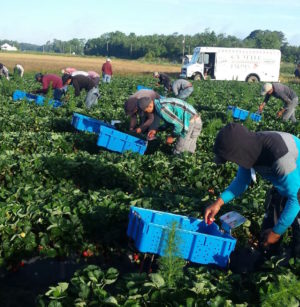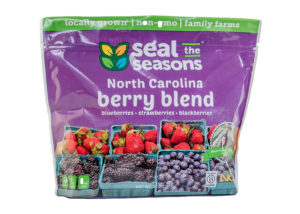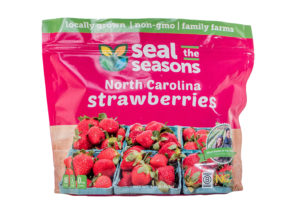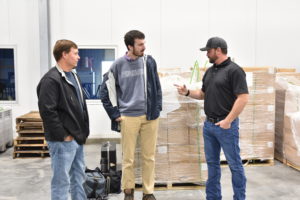How Seal the Seasons weaves connections between consumers and local food
Royce Strickland never figured himself for a model. But his picture is featured on packaging for Seal the Seasons frozen berries. It’s also on the company’s website, in a page where the frozen produce processor makes a point of letting visitors to the site know who their farmers are, by name and sharing background. “Having that little side story, I think it connects the consumer more to the brand,” said Strickland, frozen foods manager for Cottle Farms in Faison, North Carolina, one of the growers for Seal the Seasons who is also handling the company’s IQF processing in North Carolina.

where their produce comes from, and that
information can be a selling point.
“Me, I just come in and do my job and get things done. “Nobody has called and said, ‘OMG, we saw you (on the package),’ That’s not how it goes … and growers don’t care about that (getting exposure). But I think it means a lot more to the consumer.” Tom Thompson, vice president at Minnesota-based Golden Sun Marketing, thinks so as well. He describes a growing practice that has processors promoting their growers as the result of a confluence of two trends. The first, he said, is processors’ desire to present consumers with a transparent food supply chain and an understanding of where their food comes from.
“This can play out in the form of educating consumers on how their product is grown, whether it be local, organic, aquaponic, biodynamic or another method of production,” he said.
At the same time, busy consumers are increasingly seeking convenienceoriented or processed items, he adds — but thoughtfully. “They are incorporating more fresh items into their diet, but they don’t have the time to prepare it all from scratch,” he said. “We are seeing the converging of these two trends as producers aim to meet consumer demand of trusted value-added brands.”
That’s exactly what Seal the Seasons founder and CEO Patrick Mateer had in mind when he devised his company’s specialized approach to freezing fresh, local produce mid-season and make it available only in the region it is grown. His goal was to make that produce available to all consumers, year-round. Working for a fresh produce distributor in North Carolina selling local food from family farms to primarily foodservice customers and food banks, he had observed that so much local produce was only available seasonally. To keep it coming yearround, customers had to accept produce from other, outside sources.
“I embarked on Seal the Seasons so consumers and everybody could eat locally grown food year round in a convenient way that is always successful,” he said.
SCALING UP
Mateer, now 24, was still in college when he launched the business. He dropped out for a semester to participate in business competitions, hoping to win prize money to fund the startup. Those efforts netted about $80,000. He kicked off Seal the Seasons in 2015 in Chapel Hill, North Carolina. Finding success with a little over half-dozen small retailers to start, he and his small staff decided to scale the company up to work with grocery store chains in 2016. They had started out running their own IQF line in a shared commissary kitchen, then built out their own space to ramp up production as they expanded into more grocers.
Finally, the company switched to what Mateer describes as an “asset-light model” in 2017, outsourcing processing to some of their growers. “Some of our large farms have their own production capacity to create these frozen products,” he said. “We changed our model from us doing the production to partnering more with our farmers. We’re able to utilize existing capacity to produce our products.”
For example, Cottle Farms is a grower and packer that has its own IQF facility in which it processes its own products as well as those for some 20 to 30 other growers in the area. “We have packing houses for fresh, frozen, vegetable fresh and fruit fresh,” Strickland said. “We grow, we pack our own stuff, we sell, but we also pack for other growers and market their fruit.” Food safety has of course had to be a big part of the company’s process development, said Seal the Seasons Vice President of Operations Bryan Cohn.
“What makes our supply chain unique is the diversity … the sheer amount of different farms we are using, and agricultural practices they may be using,” he said. “Trying to bring it under one umbrella is a bit like herding cats.”
That led to a couple of different models. For example, some of their farmers were already sophisticated in food safety regulations and processes because they already sold to grocery stores and aggregators. Cohn said the company works with another set of growers they describe as “emerging commercial farmers.” “They would like to get into that space but for whatever reason — manpower, or lack of time to market their products, haven’t,” Cohn said. “We help them on that first step — we work with them to get them GAP certified … we walk through the expectation pieces. “We come out and do on-farm audits, actually walk with them and walk the field and discuss harvesting techniques and pesticide usage and establish a baseline of expectations.”
 The company has also set up a portal through which farmers via smartphone or computer can update food safety documentation. That gives Seal the Seasons instant access to information and data including facets like water test results. “It also allows us to give them feedback in real time,” Cohn said. “If … there’s an issue, we can alert them immediately through the portal via email … if there is something that causes us to reject it.”
The company has also set up a portal through which farmers via smartphone or computer can update food safety documentation. That gives Seal the Seasons instant access to information and data including facets like water test results. “It also allows us to give them feedback in real time,” Cohn said. “If … there’s an issue, we can alert them immediately through the portal via email … if there is something that causes us to reject it.”
EXPANSION WITH COMPASSION
By the end of 2017, Mateer anticipated having Seal the Seasons’ products in about 1,000 stores that range from typical grocery stores to convenience stores in underserved areas with limited access to local produce. In fact, the company is working with the North Carolina Department of Agriculture to pilot what Mateer described as “a healthy corner store model” where its frozen produce will be sold at reduced price in rural corner stores.
“We want to make it available for a drastically reduced price to people in those communities, subsidizing it with a small portion of our profits,” said Mateer, who was recently named to Forbes’ list of 30 Under 30 – Social Entrepreneurs. “If you’re in 1,000 grocery stores, you can easily support five or 10 corner stores with a lower price point. It’s a mission-oriented thing to make this food accessible. As we continue to grow on the for-profit side, we’ll continue to add a small number of reduced-price locations – but not in the same markets as our grocery partners. This is really a food insecurity mission.”
Seal the Seasons’ existing retailers had been mainly in North Carolina, Atlanta and Washington, D.C. The company was also getting ready to launch in Georgia and Florida as well as New Jersey and New York. “We’re partnering with family farms in each of those states, to freeze the food and sell in those states – in the same state it’s grown or maybe one over, depending on where you are in the country,” he said.

James Watts, merchandising manager for Weaver Street Market based in Hillsborough, North Carolina, with three and soon to be four locations, was among Seal the Seasons’ earliest customers. He said buying from Seal the Seasons was “a clear alignment” with Weaver Street’s mission of offering local foods. “They pitched the idea, we told them we were impressed with the company mission and product development plans and agreed to be one of their inaugural retail outlets,” Watts said.
Before, Weaver Street wasn’t carrying local frozen produce. Now that it does, customers are on board, Watts adds. “Immediately there was a lot of feedback that customers were happy to see a (local) product line,” he said. “Within six months, the (Seal the Seasons) blueberries were the number one-selling SKU in the category. What Seal the Seasons offers in a region depends on what’s grown locally. In North Carolina, the blueberries, along with strawberries, have been big sellers, individually or in blends. While the company was also freezing broccoli, they’ve shifted away from vegetables of late to focus mainly on fruit.
“It doesn’t have to be the same product in every state,” Cohn said. “It’s what’s local.” Most produce is sold at retail in 1-, 2-, or 3-pound bags, with price points generally a little above house brand, but less than organics. Ten-pound boxes also go to foodservice. And all of the packages tell the story of Seal the Seasons farmers. “We really want to make sure it’s transparent to consumers where the food is coming from,” Mateer said, “to help them understand there are real people behind this stuff. People put a lot of effort into it.”







